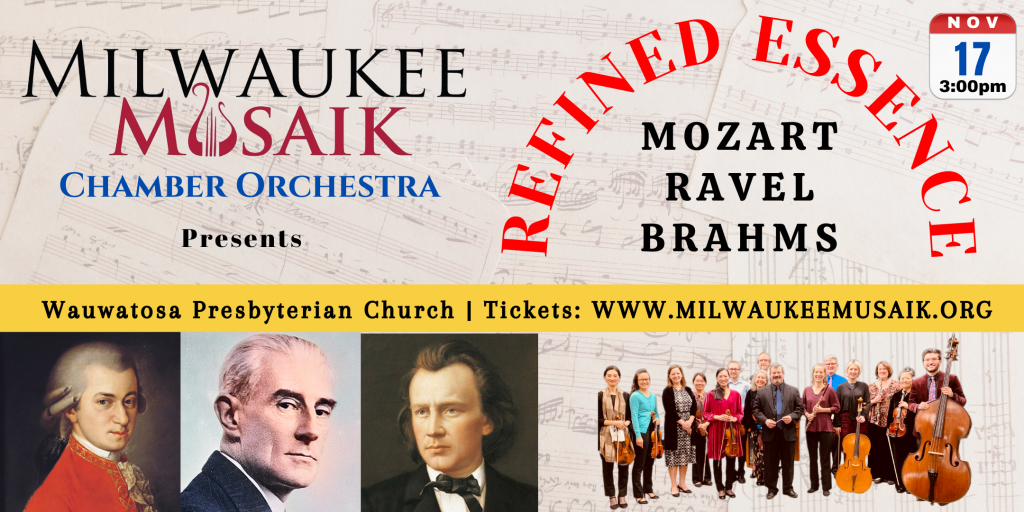Reconsidering Three Great Composers
Milwaukee Musaik performs alternate versions of Brahms and Ravel and an early work by Mozart.
All classical music has an origin story. On Sunday, Nov. 17, the “Refined Essence” program performed by Milwaukee Musaik will reveal the early chapters of such stories for symphonic compositions by Johannes Brahms (1833-1897) and Maurice Ravel (1875-1937). Musaik will play chamber versions, says conductor Alexander Mandl, that help audiences understand the essential musical ideas of the works.
Case in point: Brahms’ Serenade No. 1 in D major, Op. 11, written in 1858 for wind and string octet. Brahms’ close friend, composer and pianist Clara Schumann, had grander ideas for the piece. With Clara’s encouragement, Brahms expanded the Serenade to six movements for nine instruments. Other friends prevailed upon Brahms to write an edition for small orchestra, and he eventually scored it for full orchestra. The full orchestra version is the one most often performed today.
The score for nine instruments was never published; music historians speculate that Brahms destroyed it. However, several contemporary composers have reconstructed that early form of the Serenade. Alan Boustead was the first to tackle this task. “To reduce all the details of the existing orchestral score to a nonet would result in an unacceptable, uncharacteristic work in which all nine musicians would play almost entirely without rests,” he said. “Rather, the principle of reconstruction has been to discover textures that would have given rise to Brahms orchestrating in the way he did.”
Milwaukee Musaik will perform a reconstruction completed by bassoonist and scholar Christopher Nex (b. 1958). “Most of the reconstructions have been written by wind players,” Mandl explains. “Nex is very attentive to the ways Brahms might have used winds.”
Only nine players must cover both the solo and secondary parts of the reconstructed score. In a paper analyzing several of the reconstructed chamber versions of the Serenade, cellist Victor Minke Huls concluded that only “fantastic” players can successfully address the issue of “solo stamina versus section sharing.”
Ravel originally composed Le Tombeau de Couperin as a suite for piano solo, paying homage to François Couperin, a master composer for harpsichord. However, by the time Ravel finished the work in 1917, its six movements honored six of Ravel’s friends killed in World War I.
Ravel later transcribed four of the movements for symphony orchestra. Milwaukee Musaik will play a more intimate version for nine string and wind performers. This transcription of the orchestral arrangement was written by Australian clarinetist and composer Paul Dean. “Dean faithfully remains true to Ravel’s approach,” according to Mandl. “However, he distills the melodic material to its essence.”
Sunday’s program opens with the Divertimento for Strings in F major, K138, written when Wolfgang Amadeus Mozart (1756-1791) was just 16. A “divertimento quartet” – two violins, viola, cello and bass – will play the three-movement, nine-minute work.
Refined Essence will be performed at 3 p.m. Sunday, Nov. 17, at Wauwatosa Presbyterian Church, 2366 N. 80th St., Wauwatosa. Tickets are available online; use the code MCO20 and buy tickets by midnight Saturday for a 20 percent discount. Children 12 and under attend free when the accompanying adult buys a ticket.
If you think stories like this are important, become a member of Urban Milwaukee and help support real, independent journalism. Plus you get some cool added benefits.
Preview
-
A Sacred Choir, 70 Voices Strong
 Dec 14th, 2025 by Martha Brown
Dec 14th, 2025 by Martha Brown
-
Prometheus Trio Goes Bohemian
 Dec 3rd, 2025 by Martha Brown
Dec 3rd, 2025 by Martha Brown
-
Present Music Offers New Choral Works
 Nov 20th, 2025 by Michael Barndt
Nov 20th, 2025 by Michael Barndt





















